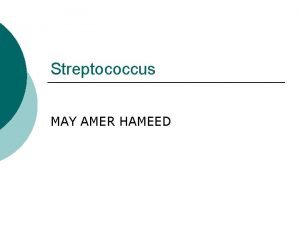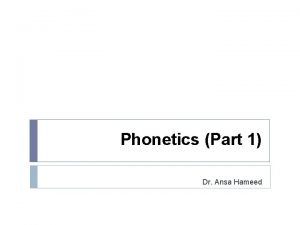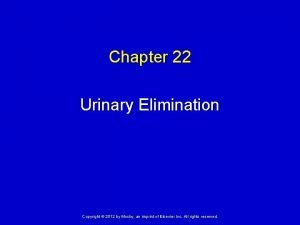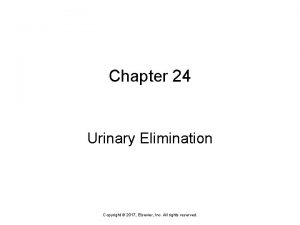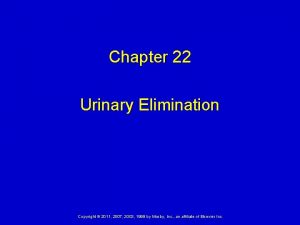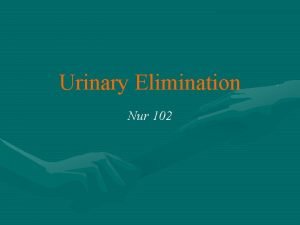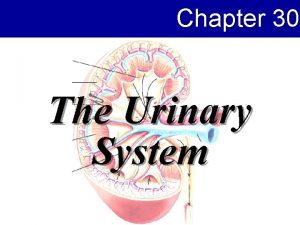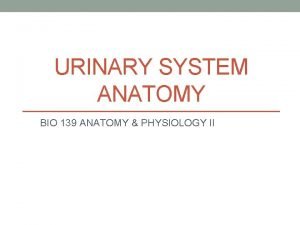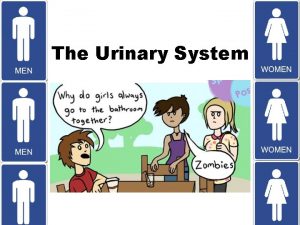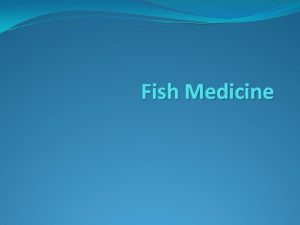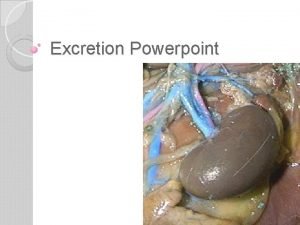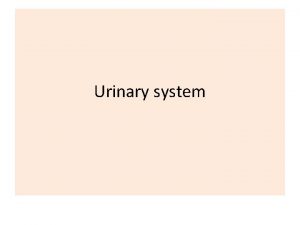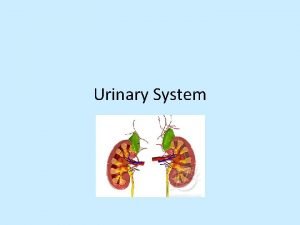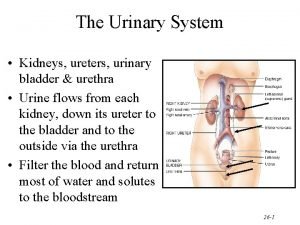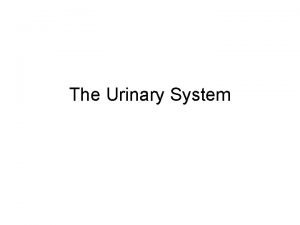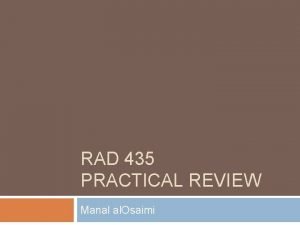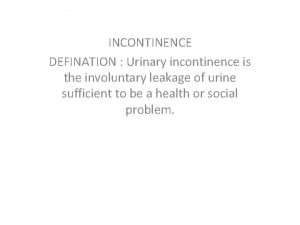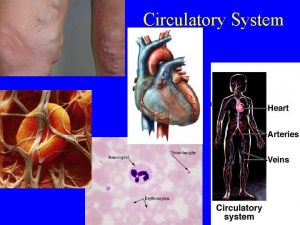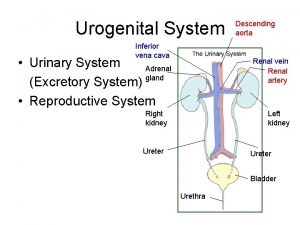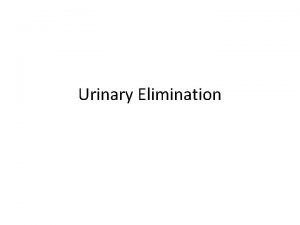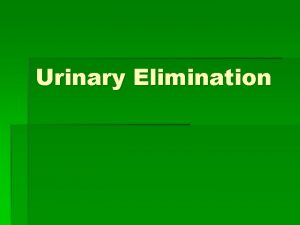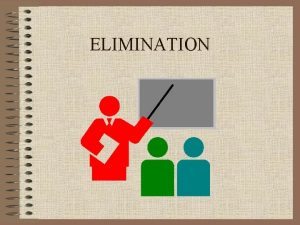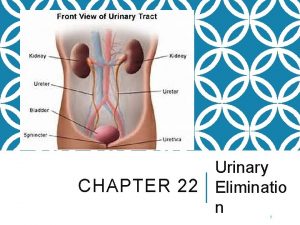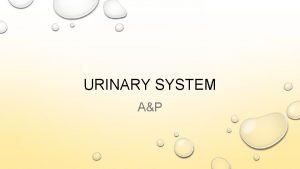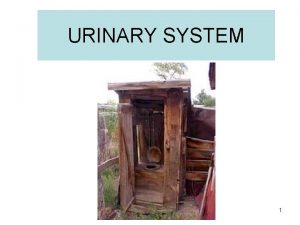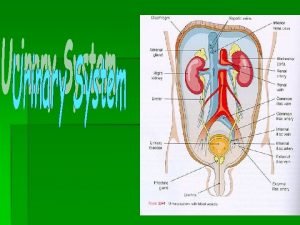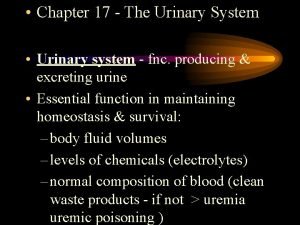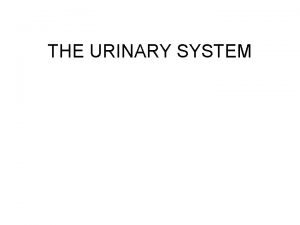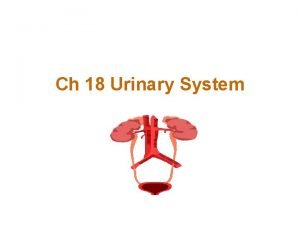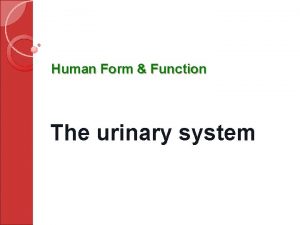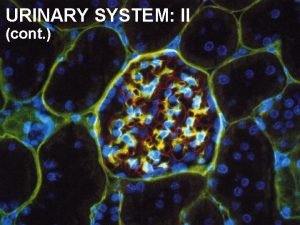Urinary elimination Dr Dergham M Hameed Urinary System

































- Slides: 33

Urinary elimination Dr. Dergham M. Hameed

Urinary System • Kidneys and ureters • Bladder • Urethra


Kidneys and Ureters • Maintain composition and volume of body fluids • Filter and excrete blood constituents not needed, retain those that are needed • Excrete waste product (urine) • Nephrons remove the end products of metabolism and regulate fluid balance • Urine from the nephrons empties into the kidneys



Bladder • Smooth muscle sac • Serves as a reservoir for urine • Composed of three layers of muscle tissue called detrusor muscle • Sphincter guards opening between urinary bladder and urethra • Urethra conveys urine from bladder to exterior of body

Urethra • Conveys urine from the bladder to the exterior • Male urethra functions in excretory and reproductive system • No portion of female urethra is external to the body

Act of Micturition • Process of emptying the bladder – Detrusor muscle contracts, internal sphincter relaxes, urine enter posterior urethra – Muscles of perineum and external sphincter relax – Muscle of abdominal wall contracts slightly – Diaphragm lowers, micturition occurs

Factors Affecting Micturition • Developmental considerations • Food and fluid intake • Psychological variables • Activity and muscle tone • Pathologic conditions • Medication

Developmental Considerations • Children – Toilet training 18 to 24 months, enuresis • Effects of aging – Nocturia, increased frequency, urine retention and stasis, voluntary control affected by physical problems

Diseases Associated With Renal Problems • Congenital urinary tract abnormalities • Polycystic kidney disease • Urinary tract infection • Urinary calculi • Hypertension • Diabetes mellitus • Gout • Connective tissue disorders


Effects of Medications on Urine Production and Elimination • Diuretics — prevent reabsorption of water and certain electrolytes in tubules • Cholingeric medications — stimulate contraction of detrusor muscle, producing urination • Analgesics and tranquilizers — suppress CNS diminish effectiveness of neural reflex

Medications Affecting Color of Urine • Anticoagulants — red color • Diuretics — lighten urine to pale yellow • Pyridium — orange to orange-red urine • Elavil — green or blue-green • Levodopa — brown or black

Using the Nursing Process • Assessing data about voiding patterns, habits, past history of problems • Physical examination of urinary system, skin hydration, urine • Correlation of these findings with results of procedures and diagnostic tests

Assessing a Problem With Voiding • Explore its duration, severity, and precipitating factors. • Note patient’s perception of the problem. • Check adequacy of patient’s self-care behaviors.


Physical Assessment of Urinary Functioning • Kidneys — check for costovertebral tenderness • Urinary bladder — palpate and percuss the bladder or use bedside scanner • Urethral meatus — inspect for signs of infection, discharge, or odor • Skin — assess for color, texture, turgor, and excretion of wastes • Urine — assess for color, odor, clarity, and sediment



Measuring Urine Output • Ask patient to void into bedpan, urinal, or specimen container in bed or bathroom. • Pour urine into appropriate measuring device. • Place calibrated container on flat surface and read at eye level. • Note amount of urine voided and record on appropriate form. • Discard urine in toilet unless specimen is needed.

Urine Specimens • Routine urinalysis • Specimens from infants and children • Clean-catch or midstream specimens • Sterile specimens from indwelling catheter • 24 -hour urine specimen


Diagnoses • Urinary functioning as the problem – Incontinence, pattern alteration, urinary retention • Urinary functioning as the etiology – Anxiety, caregiver role strain, risk for infection

Planned Patient Goals • Urine output about equal to fluid intake • Maintain fluid and electrolyte balance • Empty bladder completely at regular intervals • Report ease of voiding • Maintain skin integrity

Promoting Normal Urination • Maintaining normal voiding habits • Promoting fluid intake • Strengthening muscle tone • Stimulating urination and resolving urinary retention

Maintaining Normal Voiding Habits • Schedule • Privacy • Position • Hygiene

Patients at Risk for UTIs • Sexually active women • Postmenopausal women • Individuals with indwelling urinary catheter • Individual with diabetes mellitus • Elderly people

Four Types of Urinary Incontinence • Stress — increase in intraabdominal pressure • Urge — urine lost during abrupt and strong desire to void • Mixed — symptoms of urge and stress incontinence present • Overflow — overdistention and overflow of bladder • Functional — caused by factors outside the urinary tract

Factors to Consider With Use of Absorbent Products • Functional disability of the patient • Type and severity of incontinence • Gender • Availability of caregivers • Failure with previous treatment programs • Patient preference

Reasons for Catheterization • Relieving urinary retention • Obtaining a sterile urine specimen • Measuring amount urine in bladder • Obtaining a urine specimen • Emptying bladder before during or after surgery • Monitoring of critically ill patients

Evaluating Effectiveness of Plan • Maintain fluid, electrolyte, and acid-base balance • Empty bladder completely at regular intervals with no discomfort • Provide care for urinary diversion and when to notify physician • Develop a plan to modify factors contributing to problem • Correct unhealthy urinary habits
 Chino masjid
Chino masjid Lynch howarth incision
Lynch howarth incision Bacterial capsul
Bacterial capsul Hakim abdul hameed
Hakim abdul hameed Obstruents
Obstruents Chapter 22 urinary elimination
Chapter 22 urinary elimination Chapter 24 urinary elimination
Chapter 24 urinary elimination Chapter 22 urinary elimination
Chapter 22 urinary elimination Impaired urinary elimination
Impaired urinary elimination Alteration in urinary elimination
Alteration in urinary elimination Gauss elimination
Gauss elimination Lymphatic and urinary system
Lymphatic and urinary system Introduction of urinary system
Introduction of urinary system Chapter 15 urinary system
Chapter 15 urinary system Pyelo medical terminology
Pyelo medical terminology Interesting facts about urinary system
Interesting facts about urinary system Bladder fetal pig
Bladder fetal pig Chapter 30 the urinary system workbook answers
Chapter 30 the urinary system workbook answers Chapter 15 the urinary system figure 15-3
Chapter 15 the urinary system figure 15-3 Chapter 20 urinary/excretory system
Chapter 20 urinary/excretory system Urinary system model
Urinary system model Urinary system model
Urinary system model Fish urinary system
Fish urinary system Urinary system powerpoint
Urinary system powerpoint The urinary system is also known as
The urinary system is also known as Function of antidiuretic hormone
Function of antidiuretic hormone Ureter diameter
Ureter diameter Nephron urinary system
Nephron urinary system Hysterosalpingography
Hysterosalpingography Defination of urine
Defination of urine Urinary system label
Urinary system label Rat external anatomy
Rat external anatomy Rat urinary system
Rat urinary system Vena cava excretory system
Vena cava excretory system


